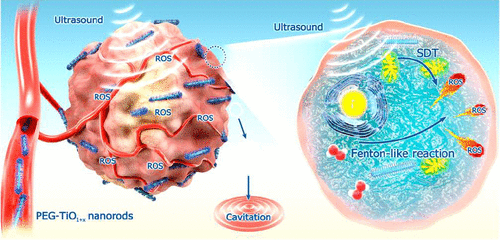当前位置:
X-MOL 学术
›
J. Am. Chem. Soc.
›
论文详情
Our official English website, www.x-mol.net, welcomes your
feedback! (Note: you will need to create a separate account there.)
Ultrafine Titanium Monoxide (TiO1+x) Nanorods for Enhanced Sonodynamic Therapy
Journal of the American Chemical Society ( IF 14.4 ) Pub Date : 2020-03-19 , DOI: 10.1021/jacs.9b10228 Xianwen Wang 1 , Xiaoyan Zhong 2 , Lixin Bai 3 , Jun Xu 1 , Fei Gong 1 , Ziliang Dong 1 , Zhijuan Yang 1 , Zhijie Zeng 3 , Zhuang Liu 1 , Liang Cheng 1
Journal of the American Chemical Society ( IF 14.4 ) Pub Date : 2020-03-19 , DOI: 10.1021/jacs.9b10228 Xianwen Wang 1 , Xiaoyan Zhong 2 , Lixin Bai 3 , Jun Xu 1 , Fei Gong 1 , Ziliang Dong 1 , Zhijuan Yang 1 , Zhijie Zeng 3 , Zhuang Liu 1 , Liang Cheng 1
Affiliation

|
Ultrasound (US)-triggered sonodynamic therapy (SDT) that enables noninvasive treatment of large internal tumors has attracted widespread interest. To improve the therapeutic responses to SDT, more effective and stable sono-sensitizers are still required. Herein, ultrafine titanium monoxide nanorods (TiO1+x NRs) with greatly improved sono-sensitization and Fenton-like catalytic activity were fabricated and used for enhanced SDT. TiO1+x NRs with an ultrafine rod-like structure were successfully prepared and then modified with polyethylene glycol (PEG). Compared to the conventional sono-sensitizer, TiO2 nanoparticles, the PEG-TiO1+x NRs resulted in much more efficient US-induced genera-tion of reactive oxygen species (ROS) due to the oxygen-deficient structure of TiO1+x NR, which predominantly serves as the charge trap to limit the recombination of US-triggered electron-hole pairs. Interestingly, PEG-TiO1+x NRs also exhibit horseradish-peroxidase-like nanozyme activity and can produce hydroxyl radicals (•OH) from endogenous tumor H2O2 to enable chemodynamic therapy (CDT). Due to their efficient passive retention in tumors post intravenous injection, PEG-TiO1+x NRs can be used as a sono-sensitizer and CDT agent for highly effective tumor ablation under US treatment. In addition, no significant long-term toxicity of PEG-TiO1+x NRs was found for the treat-ed mice. This work highlights a new type of titanium-based nanostructure with great performance for tumor SDT.
中文翻译:

用于增强声动力学治疗的超细一氧化钛 (TiO1+x) 纳米棒
超声 (US) 触发的声动力学疗法 (SDT) 能够对大型内部肿瘤进行无创治疗,引起了广泛的兴趣。为了改善对 SDT 的治疗反应,仍然需要更有效和更稳定的声敏剂。在此,制备了具有极大改善的声敏化和类芬顿催化活性的超细一氧化钛纳米棒(TiO1+x NRs),并将其用于增强的 SDT。成功制备了具有超细棒状结构的 TiO1+x NRs,然后用聚乙二醇 (PEG) 对其进行了改性。与传统的声敏剂 TiO2 纳米颗粒相比,由于 TiO1+x NR 的缺氧结构,PEG-TiO1+x NRs 导致更有效的美国诱导的活性氧 (ROS) 生成,它主要用作电荷陷阱以限制 US 触发的电子 - 空穴对的复合。有趣的是,PEG-TiO1+x NRs 还表现出类似辣根过氧化物酶的纳米酶活性,并且可以从内源性肿瘤 H2O2 中产生羟基自由基 (•OH),从而实现化学动力学治疗 (CDT)。由于静脉注射后它们在肿瘤中的有效被动保留,PEG-TiO1+x NRs 可用作超声敏化剂和 CDT 剂,在美国治疗下进行高效肿瘤消融。此外,未发现 PEG-TiO1+x NRs 对治疗小鼠有显着的长期毒性。这项工作突出了一种新型的钛基纳米结构,该结构对肿瘤 SDT 具有出色的性能。PEG-TiO1+x NRs 还表现出类似辣根过氧化物酶的纳米酶活性,可以从内源性肿瘤 H2O2 中产生羟基自由基 (•OH),从而实现化学动力学治疗 (CDT)。由于静脉注射后它们在肿瘤中的有效被动保留,PEG-TiO1+x NRs 可用作超声敏化剂和 CDT 剂,用于在美国治疗下进行高效肿瘤消融。此外,未发现 PEG-TiO1+x NRs 对治疗小鼠有显着的长期毒性。这项工作突出了一种新型钛基纳米结构,其对肿瘤 SDT 具有出色的性能。PEG-TiO1+x NRs 还表现出类似辣根过氧化物酶的纳米酶活性,可以从内源性肿瘤 H2O2 中产生羟基自由基 (•OH),从而实现化学动力学治疗 (CDT)。由于静脉注射后它们在肿瘤中的有效被动保留,PEG-TiO1+x NRs 可用作超声敏化剂和 CDT 剂,用于在美国治疗下进行高效肿瘤消融。此外,未发现 PEG-TiO1+x NRs 对治疗小鼠有显着的长期毒性。这项工作突出了一种新型钛基纳米结构,其对肿瘤 SDT 具有出色的性能。未发现 PEG-TiO1+x NRs 对治疗小鼠的显着长期毒性。这项工作突出了一种新型钛基纳米结构,其对肿瘤 SDT 具有出色的性能。未发现 PEG-TiO1+x NRs 对治疗小鼠的显着长期毒性。这项工作突出了一种新型钛基纳米结构,其对肿瘤 SDT 具有出色的性能。
更新日期:2020-03-19
中文翻译:

用于增强声动力学治疗的超细一氧化钛 (TiO1+x) 纳米棒
超声 (US) 触发的声动力学疗法 (SDT) 能够对大型内部肿瘤进行无创治疗,引起了广泛的兴趣。为了改善对 SDT 的治疗反应,仍然需要更有效和更稳定的声敏剂。在此,制备了具有极大改善的声敏化和类芬顿催化活性的超细一氧化钛纳米棒(TiO1+x NRs),并将其用于增强的 SDT。成功制备了具有超细棒状结构的 TiO1+x NRs,然后用聚乙二醇 (PEG) 对其进行了改性。与传统的声敏剂 TiO2 纳米颗粒相比,由于 TiO1+x NR 的缺氧结构,PEG-TiO1+x NRs 导致更有效的美国诱导的活性氧 (ROS) 生成,它主要用作电荷陷阱以限制 US 触发的电子 - 空穴对的复合。有趣的是,PEG-TiO1+x NRs 还表现出类似辣根过氧化物酶的纳米酶活性,并且可以从内源性肿瘤 H2O2 中产生羟基自由基 (•OH),从而实现化学动力学治疗 (CDT)。由于静脉注射后它们在肿瘤中的有效被动保留,PEG-TiO1+x NRs 可用作超声敏化剂和 CDT 剂,在美国治疗下进行高效肿瘤消融。此外,未发现 PEG-TiO1+x NRs 对治疗小鼠有显着的长期毒性。这项工作突出了一种新型的钛基纳米结构,该结构对肿瘤 SDT 具有出色的性能。PEG-TiO1+x NRs 还表现出类似辣根过氧化物酶的纳米酶活性,可以从内源性肿瘤 H2O2 中产生羟基自由基 (•OH),从而实现化学动力学治疗 (CDT)。由于静脉注射后它们在肿瘤中的有效被动保留,PEG-TiO1+x NRs 可用作超声敏化剂和 CDT 剂,用于在美国治疗下进行高效肿瘤消融。此外,未发现 PEG-TiO1+x NRs 对治疗小鼠有显着的长期毒性。这项工作突出了一种新型钛基纳米结构,其对肿瘤 SDT 具有出色的性能。PEG-TiO1+x NRs 还表现出类似辣根过氧化物酶的纳米酶活性,可以从内源性肿瘤 H2O2 中产生羟基自由基 (•OH),从而实现化学动力学治疗 (CDT)。由于静脉注射后它们在肿瘤中的有效被动保留,PEG-TiO1+x NRs 可用作超声敏化剂和 CDT 剂,用于在美国治疗下进行高效肿瘤消融。此外,未发现 PEG-TiO1+x NRs 对治疗小鼠有显着的长期毒性。这项工作突出了一种新型钛基纳米结构,其对肿瘤 SDT 具有出色的性能。未发现 PEG-TiO1+x NRs 对治疗小鼠的显着长期毒性。这项工作突出了一种新型钛基纳米结构,其对肿瘤 SDT 具有出色的性能。未发现 PEG-TiO1+x NRs 对治疗小鼠的显着长期毒性。这项工作突出了一种新型钛基纳米结构,其对肿瘤 SDT 具有出色的性能。











































 京公网安备 11010802027423号
京公网安备 11010802027423号